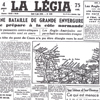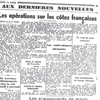National Content: Belgium
A full scale battle
| Source | "La Légia" n°1236, the 8th of June 1944, P.1, 3. |
| Event referred to | 6th June 1944 : D - Day |
| Technological characteristics | Type of file: Image Extension : pdf Characteristics Dimension of the file: < 2000 Ko Availability proposed: pdf document with zoom options |
| Description of the source | Kind of source: Daily newspaper Origin of the source: Archives of the National Library of Belgium, Brussels Language: French Copyright issues: reproduction and pedagogical exploitation authorized in the framework of the MHM project |
| Contextualisation of the source | « La Légia » is a daily newspaper published from 25th May 1940 till 1st September 1944, and pressed at the newspaper “La Meuse” which was sequestered by the German authorities. In the occupied Belgium, “La Légia” is a newspaper of propaganda which reflects the political and military points of view of the German occupant. |
| Interpretation of the source | The newspaper titles on its first page “A full scale battle“ and presents a map of Normandy. The article of the first page relates the facts in a deep and quite objective way. It recalls the American and British parachuting, on Sainte-Mer-Eglise and on the bridges of the Orne. It speaks about the importance of the forces engaged by the Allies on earth, at sea and in the air. It is about “the most powerful attack that the enemies have never started in the air”. The importance of that stake is underlined by the decision of the enemy who won’t move back in front of no sacrifice. From the beginning, the newspaper has then understood the importance of the event. Nevertheless, behind the appearance of objectivity, the journalists use all the possible means to minimize the consequences of the event for the readers. First of all, the sources are exclusively German, that confirms the bias of the newspaper. Moreover, the articles underline the Anglo-American “heavy losses”, the “numerous prisoners” captured by the Germans, the “stormy sea” and the “cloudy sky” that seriously bother the military operations of landing. Then, the vocabulary used in this article presents the Allies as the attackers. We speak about “invasion”, about “endangered region”, and about “enemies”. We recall the “ravages caused by the air bombings” and the anger of the Norman people, victim of the bombings. Inversely, the German actions are enhanced. We speak about “powerful counterattacks” which inflict “heavy losses” on “the enemy”. In the inner pages, each local success of the Wehrmacht, of the Luftwaffe or of the Kriegsmarine, is recalled. All that to the detriment of the general situation which remains, as we all know, at the advantage of the Allies. Still on the first page, the journalists comment on the event. They underline the importance of the destructions caused by the Anglo-Americans and the strike that these “renegades”, these “assailants” give to the European civilization by destroying the “spiritual and cultural heritage” of the continent. In the same way, they warn the readers of the “horrible and painful days” to come and of the deprivations that populations could suffer. In short, behind the appearance of an official and objective war release, «La Légia» presents the German army as the bulwark of the European civilization in front of the Anglo-American barbarism and invites its readers not to cherish illusory hopes. |
| Original Contents | |
| Original Contents (English Translation) |

